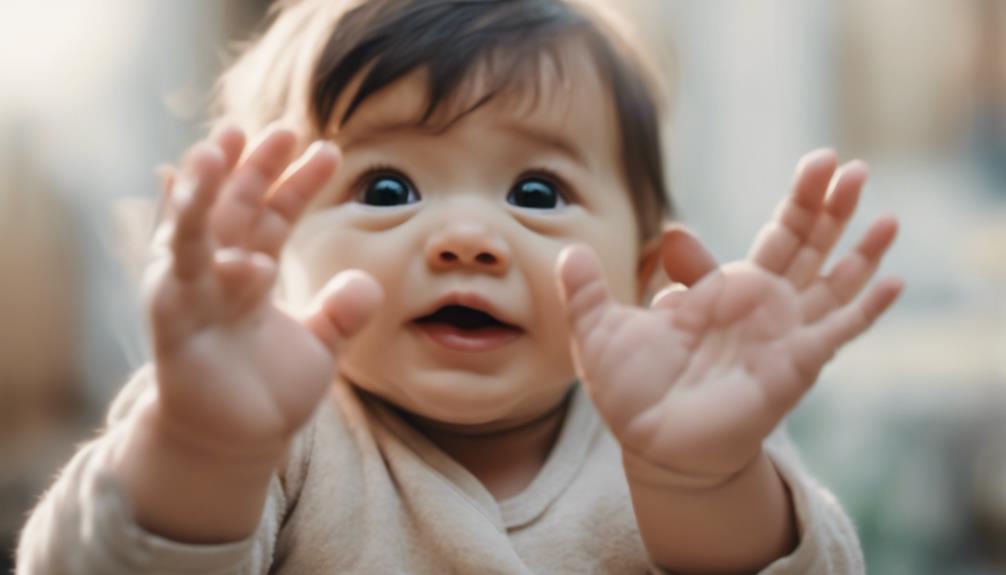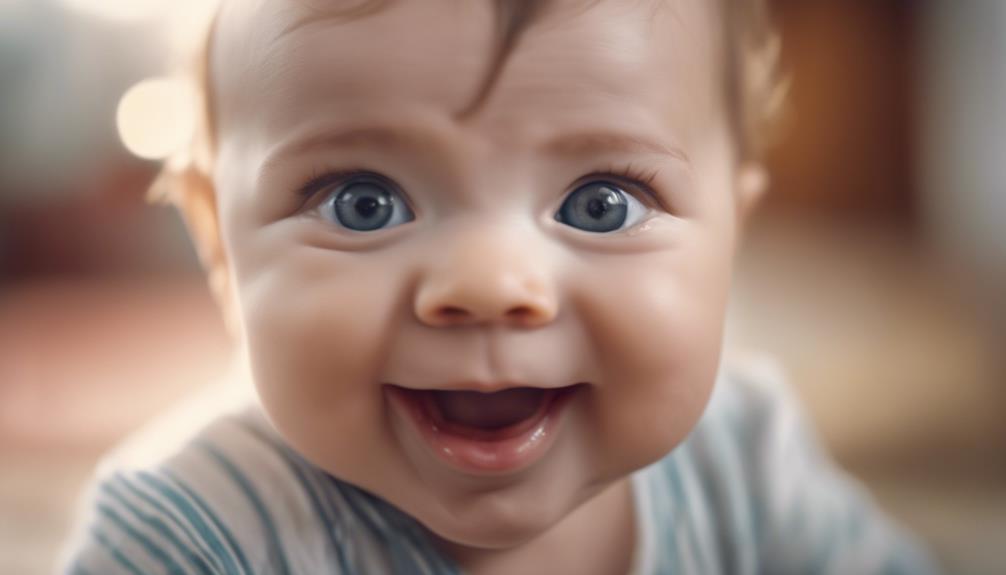To determine if a baby is fond of you, observe their smiling, reaching out, and positive reactions to your voice. Eye contact shows recognition and trust, enhancing your connection. When held, calmness and relaxation indicate comfort and safety. Cooing, babbling, and being content in your presence show love. Mimicking behaviors and interacting with you build stronger bonds. Look for subtle signs like snuggling, falling asleep to your voice, or imitating sounds. These cues can reveal a baby’s feelings towards you. Paying attention to subtle signals is crucial in understanding a baby’s affection and can offer valuable insights into your relationship with them.
Key Takeaways
- Smiling, reaching out, and cooing show affection.
- Eye contact signifies recognition, trust, and affection.
- Calmness, relaxation, and snuggling indicate comfort.
- Mirroring behavior and engaging show interest.
- Falling asleep or relaxing to your voice means comfort.
Eye Contact
Making eye contact with a baby is a key way to gauge their feelings towards you. When a baby locks eyes with you, it signifies more than just a visual connection. It's a powerful form of communication that can strengthen the bond between you and the baby.
Babies often use eye contact to show recognition, trust, and affection towards their caregivers. A baby maintaining eye contact with you indicates their interest and engagement in the interaction, displaying a sense of comfort and security in your presence.
The quality and duration of eye contact can vary, but consistent eye contact is a positive sign of attachment. By meeting a baby's gaze and reciprocating their eye contact, you're fostering a sense of connection and understanding that's essential for building a strong relationship.
Smiling Behavior

Eye contact is a key indicator of a baby's feelings towards you, and another significant behavior to take into account is smiling. When a baby flashes those social smiles between 6-8 weeks old, it's a clear signal of a positive emotional connection.
These genuine signs of liking and bonding show that the little one associates your presence with happiness and comfort. As you engage in interactions with the baby, pay attention to whether they mirror your smile.
This mirroring behavior isn't just cute; it's a powerful indication of a connection and positive interaction between you and the baby. By reciprocating smiles, babies deepen their bond with caregivers, fostering a sense of affection and trust.
Reaching Out Gestures

When a baby reaches out to you, it's a clear indication of their desire for closeness and comfort. This gesture showcases their trust in your presence and can strengthen your bond with them.
Responding to their reaching out gestures helps foster a sense of security and attachment, creating a positive interaction between you and the baby.
Eye Contact
You can gauge a baby's affection by observing their nonverbal cues, such as reaching out gestures and engaging eye contact. When a baby locks eyes with you, it signifies a deep connection and bond.
This eye contact isn't just a gaze; it reflects the trust and attachment the baby feels towards you. As you hold or feed the baby, maintaining eye contact is a powerful indicator of their liking and recognition of you.
Babies may study your face intently, trying to understand your expressions and emotions, which further solidifies the bond between you. Responding positively to your voice and presence, especially through eye contact, showcases the baby's affection and trust in you.
Smiling Interactions
Engaging in smiling interactions with a baby can provide insight into their feelings towards you. When a baby smiles at you, it's a clear sign of positive interaction and connection. Responding with a smile of your own not only deepens the bond but also shows mutual affection. Babies may also accompany their smiles with reaching out gestures, like holding out their arms towards you, indicating a desire for closeness and comfort.
During these smiling interactions, pay attention to the baby's facial expressions and eye contact. Smiling back and maintaining eye contact can further strengthen the bond and show your interest in the baby.
Additionally, positive vocal interactions, such as cooing and babbling while smiling, are further signs that the baby enjoys your presence and likes being around you. These subtle cues in smiling interactions form the basis for understanding the baby's feelings and building a positive relationship with them.
Calmness When Held

Feeling a baby's calmness in your arms can indicate a strong sense of security and comfort they find in your presence. When a baby displays this serene demeanor while being held by you, it signifies a deep level of trust and affection towards you.
Here are some subtle signs to look out for:
- Relaxation: If the baby relaxes and settles down in your embrace, it shows they enjoy your touch and feel at ease with you.
- Body Language: Pay attention to how the baby responds to being held by you as their gestures can reveal their true feelings towards you.
- Snuggling: The way a baby snuggles into you or nuzzles against your chest can be a heartwarming sign of affection and liking.
- Reaction: Observing the baby's reaction when you pick them up can provide valuable insights into their feelings of comfort and attachment towards you.
These subtle cues can help strengthen the bond between you and the baby, fostering a nurturing and loving relationship.
Cooing and Babbling

When a baby coos and babbles in your presence, they're expressing their affection and trust towards you. These early communication sounds are a sign of their comfort and liking, indicating a strong connection.
Pay attention to the frequency and tone of their vocal expressions, as they can reveal the level of attachment and joy the baby feels towards you.
Vocal Expressions
Pay attention to your baby's cooing and babbling as they're clear indicators of their liking and connection towards you. When your baby engages in vocal expressions like cooing and babbling, it's their way of communicating with you and expressing their feelings of comfort and enjoyment in your presence.
Here's how to interpret these subtle signs:
- Tone and Pitch: The pitch and tone of your baby's cooing and babbling can convey their liking and attachment towards you.
- Rhythm: Notice the rhythm of their vocalizations as it can reveal their feelings of affection and connection.
- Changes in Interaction: Pay attention to how your baby's cooing and babbling changes when you interact with them, as it can indicate their growing fondness for you.
- Engagement: Vocal expressions like cooing and babbling are ways for babies to engage with you and show their interest and liking towards you.
Understanding these vocal cues can help strengthen the bond between you and your baby.
Communication Sounds
Listen closely to your baby's cooing and babbling to understand their early forms of communication and expressiveness. When your baby coos and babbles, they aren't just making random sounds; they're engaging in a form of communication that signifies their liking and attachment towards you.
These sounds are the baby's way of letting you know that they're learning to connect and express themselves. As you interact with your baby, pay attention to the tone and pitch of their cooing and babbling. The way they vocalize can convey a range of emotions, from comfort and joy to seeking attention.
When your baby looks deep into your eyes while cooing or babbling, it's a sign of love and connection. Encourage this communication by responding positively, as babies often engage in trial and error to express themselves effectively.
Contentment in Your Presence

To recognize contentment in your presence, observe how the baby relaxes, smiles, or makes soft cooing sounds. When a baby likes you, they might seek physical contact by reaching out their arms or nuzzling into your chest. Additionally, babies may show signs of affection by making eye contact, tracking your movements, or turning towards your voice. Here are some ways you can tell if a baby is content in your presence:
- Physical Cues: Watch for the baby reaching out to touch you or leaning towards you for comfort.
- Facial Expressions: Look for smiles, relaxed facial muscles, or bright eyes that indicate happiness.
- Vocalizations: Listen for soft cooing sounds, babbling, or giggles that show the baby is enjoying your company.
- Body Language: Notice if the baby's body is relaxed, with open hands and a calm demeanor, which suggests they feel safe and comfortable with you.
Positive Reaction to Your Voice

Moreover, babies often exhibit a positive response to your voice, showing their liking for you through various cues and behaviors. Your baby's turning towards your familiar voice is a clear indication of their affection.
When they calm down or become more alert upon hearing you speak, it's a sign of a positive reaction. Coos and babbles in response to your voice are direct ways your baby expresses fondness for you.
Making eye contact while you talk not only shows engagement but also signifies their enjoyment of your presence. Moreover, signs of excitement or happiness when they hear your voice are strong indicators of their liking towards you.
These subtle yet significant reactions demonstrate the deep connection and bond your baby feels with you through the sound of your voice. Pay attention to these cues to strengthen your relationship and understanding with your little one.
Frequently Asked Questions
How Can You Tell if Your Baby Likes You?
You can tell if your baby likes you by observing their reactions to your presence. Look for cues like eye contact, smiling, and seeking comfort. Pay attention to how they respond to your touch, voice, and facial expressions.
How Do I Know if My Baby Is Attached to Me?
When your baby is attached to you, they seek comfort, show joy in your presence, and look for security from you in difficult times. Watch for their happiness when near and their distress when apart.
How Do You Know if Your Baby Is Looking at You?
You know your baby is looking at you when they make eye contact, turn towards your voice, and open their mouth to your familiar scent. When they relax in your arms and smile or babble, it's clear they like you.
Can Babies Sense When You Don't Like Them?
Babies sense your emotions, but they focus on positive interactions. They feel loved through care and attention. To bond with a baby, offer affection and create a supportive environment. Your love is what they feel.
Conclusion
To sum up, the subtle signs that a baby likes you can be easily observed through their:
- Eye contact
- Smiling behavior
- Reaching out gestures
- Calmness when held
- Cooing and babbling
- Contentment in your presence
- Positive reaction to your voice
By paying attention to these cues, you can build a strong bond with the baby and foster a positive relationship.
So next time you interact with a baby, keep an eye out for these signs to gauge their feelings towards you.










